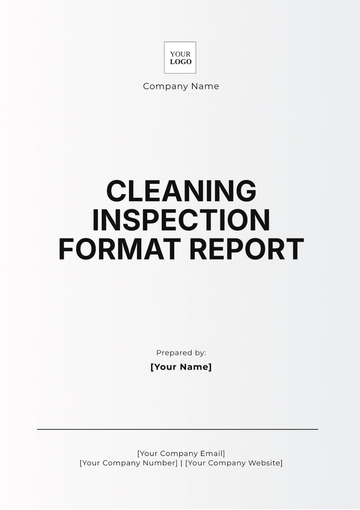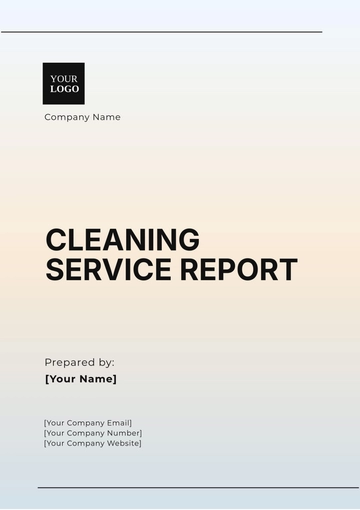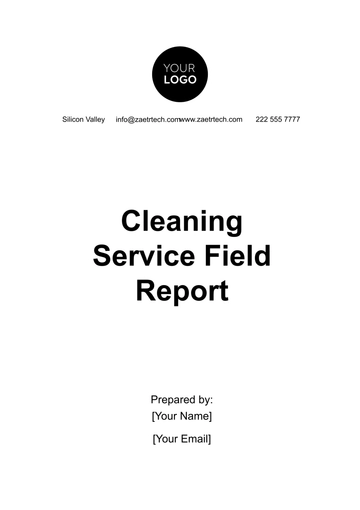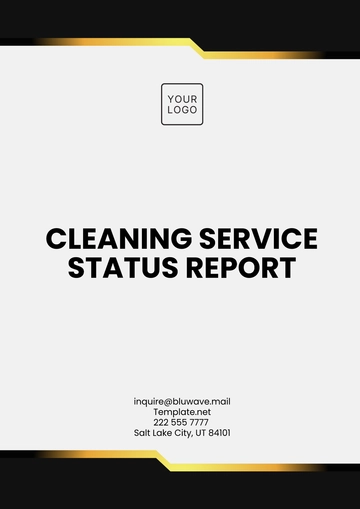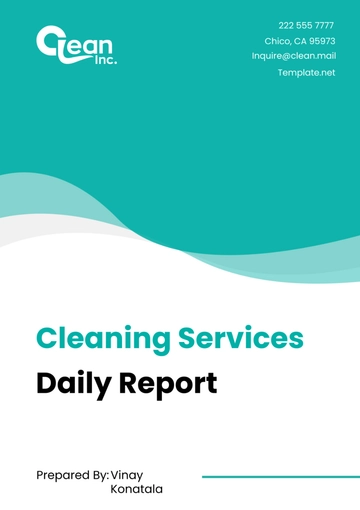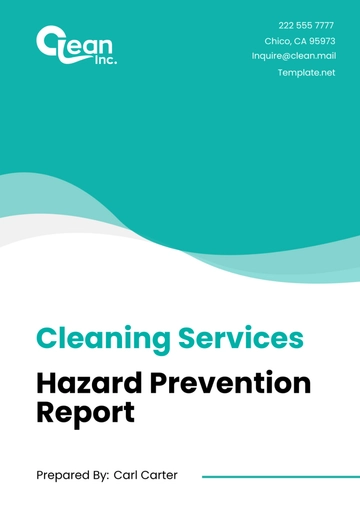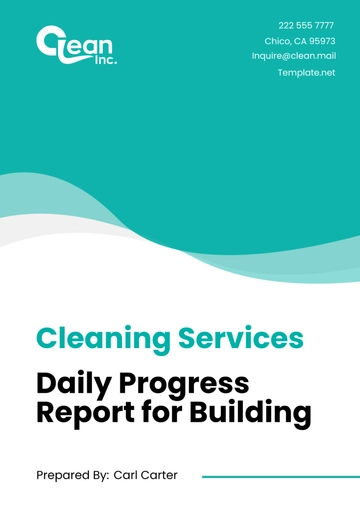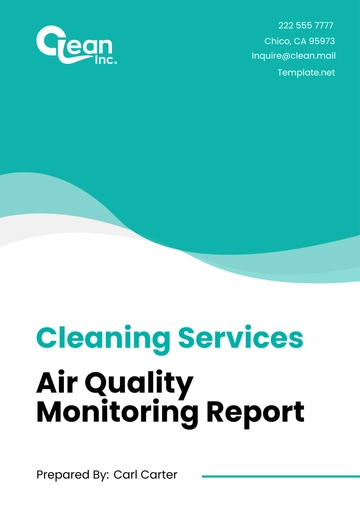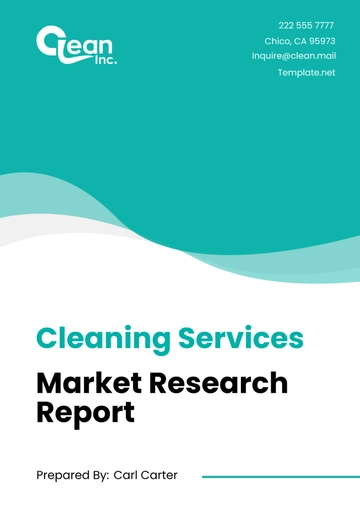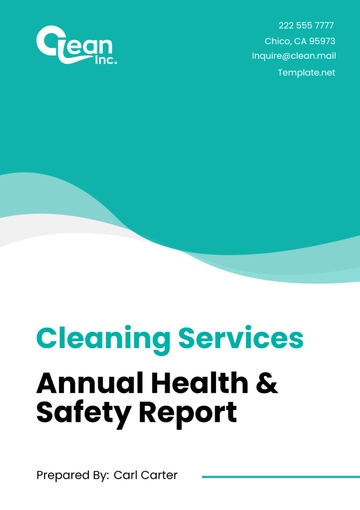Free Cleaning Services Annual Health & Safety Report
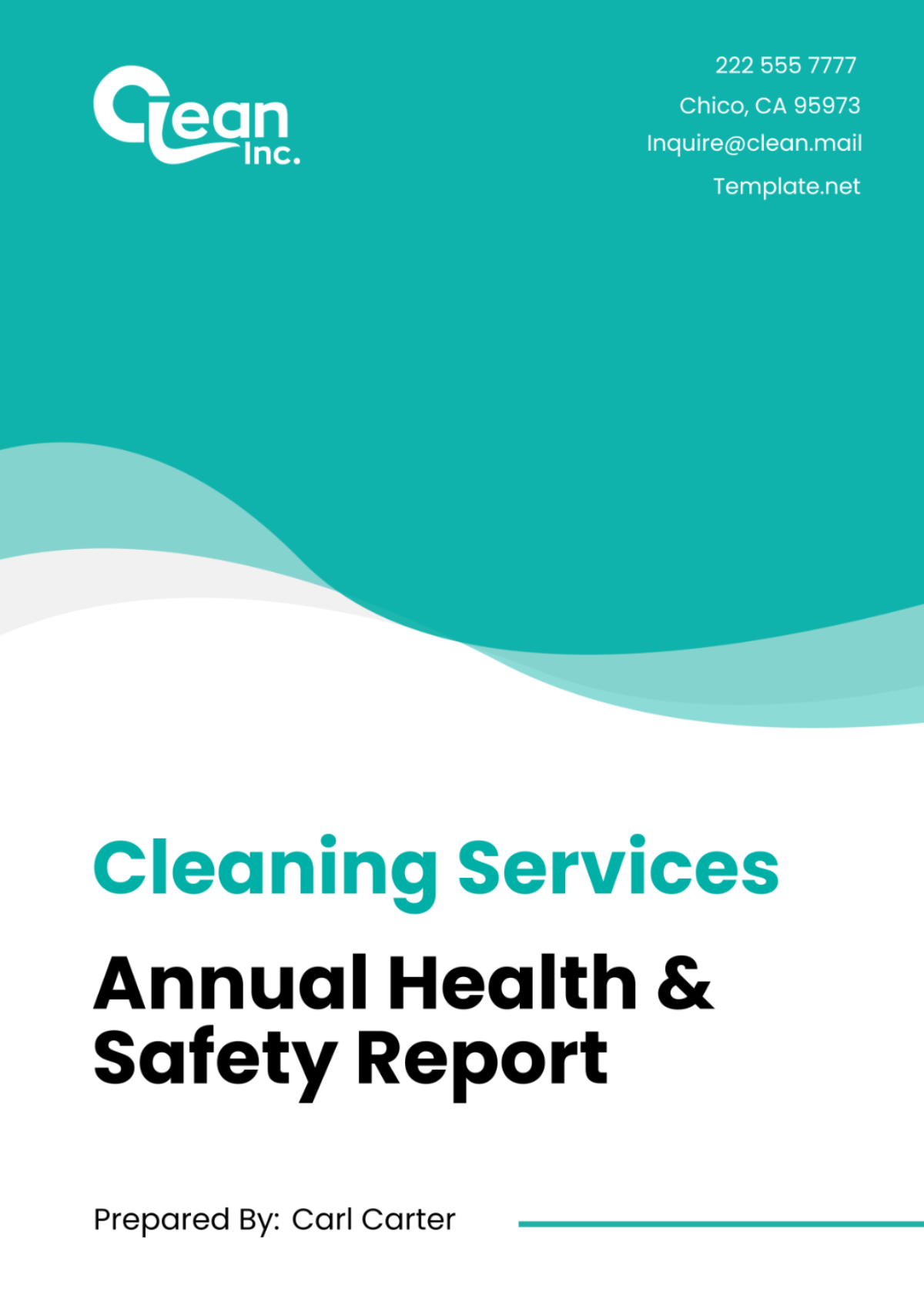
I. Introduction
This Cleaning Services Annual Health & Safety Report encapsulates our commitment to fostering a culture of safety, both within our organization and across the clients we serve. As an integral part of our operations, prioritizing the well-being of our employees and stakeholders remains paramount, and this report serves as a testament to our relentless efforts in this regard.
Throughout the reporting period spanning from [Start Date], to [End Date], [Your Company Name] has diligently monitored and addressed various aspects of health and safety within our operations. From incident management and compliance with regulatory standards to proactive risk assessments and the implementation of best practices, each section of this report reflects our unwavering dedication to ensuring a safe working environment for all. As we navigate the complexities of the cleaning services industry, we remain steadfast in our pursuit of excellence, continually striving to set new benchmarks for safety and professionalism.
II. Incident and Accident Statistics
During the reporting period, [Your Company Name] meticulously tracked and analyzed all incidents and accidents to provide a comprehensive overview of safety performance.
A. Overview of Incident and Accident Statistics:
The following table provides a breakdown of incident types, their frequencies, and the severity of injuries sustained. This comprehensive analysis serves as a foundation for our ongoing efforts to enhance safety protocols and mitigate risks within our operations.
Incident Type | Number of Incidents | Percentage of Total Incidents | Severity of Injuries |
|---|---|---|---|
Slips, Trips, Falls | 8 | 66.67% | Minor bruises, sprains, twisted ankles |
Chemical Exposure | 2 | 16.67% | Eye irritation, mild skin reactions, respiratory discomfort |
Equipment Malfunction | 1 | 8.33% | Minor cuts, abrasions |
Other | 1 | 8.33% | None reported |
B. Severity of Injuries Breakdown:
Minor bruises, sprains, twisted ankles: 50%
Eye irritation, mild skin reactions, respiratory discomfort: 30%
Minor cuts, abrasions: 20%
The breakdown of incident severity into categories provides valuable insights into the types of injuries encountered within [Your Company Name]'s operations. The fact that minor bruises, sprains, and twisted ankles account for 50% of incidents suggests that slips, trips, and falls are significant contributors to workplace injuries. This highlights the importance of maintaining clean and dry surfaces, implementing proper signage, and providing adequate training on hazard awareness and prevention to reduce the risk of such incidents.
The occurrence of eye irritation, mild skin reactions, and respiratory discomfort in 30% of incidents indicates a notable presence of chemical hazards or airborne contaminants in the workplace. This emphasizes the need for strict adherence to chemical safety protocols, including proper handling, storage, and use of cleaning chemicals, as well as the provision of appropriate personal protective equipment (PPE) to mitigate exposure risks.
Additionally, the presence of minor cuts and abrasions in 20% of incidents underscores the importance of equipment safety and proper handling procedures. Regular equipment maintenance, along with employee training on safe operation practices, can help minimize the risk of injuries related to equipment malfunction or misuse.
C. Details of Incidents:
Slips, Trips, Falls: The majority of incidents in this category occurred due to wet floors, uneven surfaces, or obstacles left unattended. Immediate response and first aid were provided to affected individuals, and corrective actions, including increased signage and floor drying procedures, were implemented promptly.
Chemical Exposure: These incidents primarily resulted from improper handling of cleaning chemicals or inadequate personal protective equipment (PPE). Employees were promptly treated, and additional training sessions focusing on chemical safety protocols were conducted to prevent future occurrences.
Equipment Malfunction: One incident involved a malfunctioning vacuum cleaner, resulting in minor cuts to the operator's hand. The equipment was promptly removed from service, repaired, and subjected to thorough inspection before being returned to use. Enhanced equipment maintenance protocols were subsequently implemented.
Other: The incident in this category involved a near miss during high-pressure cleaning operations. While no injuries occurred, it prompted a review of our procedures and the implementation of additional safety measures to prevent similar incidents in the future.
Fortunately, there were no severe injuries reported during the reporting period. These statistics highlight the need for continued vigilance and targeted safety measures to mitigate risks associated with slips, trips, falls, chemical exposure, and equipment malfunction. [Your Company Name] remains committed to implementing proactive measures to ensure the safety and well-being of our employees and clients.
II. Compliance with Regulations
Throughout the reporting period, [Your Company Name] remained steadfast in its commitment to upholding stringent health and safety regulations governing the cleaning services industry. Our dedication to compliance was evident through proactive measures and rigorous adherence to regulatory standards.
A. Regulatory Compliance Initiatives:
Regular Audits: [Your Company Name] conducted routine audits to ensure alignment with local, state, and federal regulations pertaining to health and safety in the workplace. These audits encompassed thorough reviews of safety protocols, equipment maintenance records, and employee training documentation.
Ongoing Training: To maintain compliance with evolving regulations, [Your Company Name] provided continuous training sessions for all employees. These sessions covered a wide range of topics, including proper handling of cleaning chemicals, safe operation of equipment, and emergency response procedures.
Regulatory Updates: [Your Company Name] remained vigilant in monitoring regulatory changes and updates. We promptly disseminated relevant information to employees and implemented necessary adjustments to ensure ongoing compliance with updated regulations.
B. Results and Compliance Metrics:
100% Compliance: [Your Company Name] is pleased to report a 100% compliance rate with all applicable health and safety regulations throughout the reporting period. This achievement underscores our unwavering commitment to regulatory adherence and underscores our dedication to maintaining the highest standards of safety.
Regulatory Certifications: [Your Company Name] obtained and maintained all required certifications and licenses essential for operating within the cleaning services industry. These certifications serve as tangible evidence of our compliance with regulatory requirements and provide assurance to clients and stakeholders.
Continuous Improvement: While achieving full compliance, [Your Company Name] also recognized the importance of continuous improvement. We proactively identified areas for enhancement, implementing corrective actions and preventive measures to further strengthen our adherence to regulations and enhance overall safety performance.
III. Training and Education Initiatives
We recognize that comprehensive training and education are essential components of a robust health and safety program. Throughout the reporting period, we implemented a wide range of initiatives aimed at enhancing the knowledge, skills, and awareness of our employees regarding health and safety practices in the cleaning services industry.
A. Training Program Overview:
Tailored Curriculum: [Your Company Name] developed a customized training curriculum tailored to the specific needs and challenges encountered within our operations. This curriculum covered a diverse array of topics, including but not limited to chemical safety, equipment operation, ergonomics, and emergency response protocols.
Multi-Modal Delivery: To accommodate different learning styles and preferences, [Your Company Name] utilized a combination of training methods, including in-person workshops, online modules, practical demonstrations, and interactive simulations. This multi-modal approach ensured maximum engagement and effectiveness among employees.
Regular Sessions: [Your Company Name] conducted regular training sessions throughout the reporting period, with a focus on both new hires and existing employees. These sessions were scheduled at convenient times and locations to minimize disruption to daily operations while ensuring comprehensive coverage of essential topics.
B. Advanced Training Initiatives:
Specialized Training: In addition to general health and safety training, [Your Company Name] offered specialized sessions addressing specific hazards and risks encountered in the cleaning services industry. This included training on the safe handling of hazardous substances, proper use of personal protective equipment (PPE), and techniques for working at height.
Certification Programs: [Your Company Name] facilitated participation in certification programs relevant to the cleaning services sector. Employees were encouraged to obtain certifications such as OSHA (Occupational Safety and Health Administration) certifications, first aid training, and CPR (Cardiopulmonary Resuscitation) certification to further enhance their skills and qualifications.
C. Outcome Assessment and Feedback Mechanisms:
Evaluation Tools: [Your Company Name] implemented robust evaluation tools to assess the effectiveness of training initiatives. These tools included pre- and post-training assessments, practical demonstrations, and knowledge checks to gauge comprehension and retention of key concepts.
Feedback Channels: [Your Company Name] actively solicited feedback from employees regarding the training programs, encouraging open communication and suggestions for improvement. Feedback mechanisms such as surveys, focus groups, and one-on-one discussions were utilized to gather insights and address any concerns or areas for enhancement.
D. Continuous Improvement and Future Outlook:
[Your Company Name] remains committed to continuous improvement in training and education initiatives. As we look to the future, we will continue to refine and expand our training programs, incorporating emerging best practices, technological advancements, and industry-specific developments. By investing in the ongoing development of our workforce, [Your Company Name] strives to maintain a culture of excellence and ensure the highest standards of health and safety in all aspects of our operations.
IV. Risk Assessments and Mitigation Measures
[Your Company Name] conducted comprehensive risk assessments and implemented targeted mitigation measures to proactively identify and address potential hazards within our operations. Our proactive approach to risk management reflects our commitment to ensuring the safety and well-being of our employees and clients.
A. Risk Assessment Process:
Systematic Identification: [Your Company Name] employed a systematic approach to identify potential hazards and risks within our operations. This process involved conducting thorough site inspections, analyzing past incident data, and soliciting input from employees to identify areas of concern.
Hazard Prioritization: Following the identification of hazards, [Your Company Name] prioritized them based on factors such as severity, likelihood of occurrence, and potential impact on safety. This prioritization helped focus mitigation efforts on addressing the most critical risks first.
B. Mitigation Measures Implementation:
Proactive Measures: [Your Company Name] implemented proactive measures to mitigate identified risks and hazards. These measures included the introduction of engineering controls, administrative controls, and personal protective equipment (PPE) to reduce exposure to hazards and minimize the likelihood of incidents.
Employee Training: [Your Company Name] provided comprehensive training to employees on hazard recognition, mitigation techniques, and emergency response protocols. This training empowered employees to identify and address hazards in real time, enhancing overall safety within our operations.
Regular Equipment Maintenance: [Your Company Name] instituted a rigorous schedule for the inspection and maintenance of cleaning equipment. Regular servicing and upkeep of machinery ensured optimal functionality, reducing the risk of equipment-related accidents and malfunctions.
Emergency Preparedness Plans: [Your Company Name] developed and implemented emergency preparedness plans tailored to the specific hazards present within our operations. These plans outlined procedures for responding to emergencies such as spills, chemical exposures, or equipment failures, ensuring swift and effective response in crisis situations.
C. Continuous Monitoring and Review:
Regular Inspections: [Your Company Name] conducted regular inspections of worksites and equipment to ensure ongoing compliance with mitigation measures and to identify any new or emerging hazards. These inspections were conducted by trained personnel and documented to track progress and identify areas for improvement.
Incident Analysis: [Your Company Name] analyzed incident data to identify trends and patterns that could indicate underlying hazards or systemic issues. Insights gleaned from incident analysis were used to refine existing mitigation measures and develop new strategies to address evolving risks.
Safety Committees: [Your Company Name] established safety committees comprised of representatives from various departments and levels of the organization. These committees met regularly to review safety performance, discuss incident reports, and collaboratively identify opportunities for improvement.
Employee Feedback Mechanisms: [Your Company Name] implemented employee feedback mechanisms, such as suggestion boxes, anonymous surveys, and open-door policies, to encourage continuous communication regarding safety concerns and suggestions for improvement. Employees were actively encouraged to participate in safety discussions and provide input on safety-related matters.
D. Collaboration and Communication:
Client Engagement: [Your Company Name] actively engaged with clients to collaboratively identify and address hazards within their facilities. This collaborative approach fostered a shared commitment to safety and facilitated the implementation of effective mitigation measures across all worksites.
Open Communication: [Your Company Name] encouraged open communication and feedback from employees regarding potential hazards and mitigation measures. Employees were encouraged to report any safety concerns or near misses promptly, allowing for timely intervention and corrective action.
V. Best Practices and Recommendations
Based on our experiences and observations in 2023, Cleaning Excellence recommends the following best practices for the cleaning services industry:
Regular safety audits and inspections to identify and address potential hazards.
Continuous employee training and refresher courses to reinforce safety protocols.
Collaboration with clients to ensure a shared commitment to health and safety standards.
Investment in advanced cleaning technologies and equipment to enhance efficiency and safety.
Establishment of a robust incident reporting and investigation process to promptly address any safety concerns.
VI. Conclusion
In conclusion, [Your Company Name] is committed to maintaining the highest standards of health and safety within the cleaning services industry. Through diligent risk assessments, proactive mitigation measures, and continuous monitoring and review, we strive to create a safe and healthy work environment for our employees and clients alike. Our dedication to compliance with regulations, comprehensive training initiatives, and collaborative approach to hazard identification and mitigation underscores our unwavering commitment to safety excellence.
As we move forward, [Your Company Name] will continue to prioritize safety as a core value, striving for continual improvement and innovation to ensure the well-being of all stakeholders. Together, we will uphold our shared responsibility to foster a culture of safety and uphold the highest standards of professionalism within the cleaning services industry.
Prepared By:

[Your Name]
[Your Position]
[Your Company Name]
- 100% Customizable, free editor
- Access 1 Million+ Templates, photo’s & graphics
- Download or share as a template
- Click and replace photos, graphics, text, backgrounds
- Resize, crop, AI write & more
- Access advanced editor
Ensure ongoing safety excellence in your cleaning services with Template.net's Annual Health & Safety Report Template. Editable via our AI Editor Tool, this customizable template streamlines the compilation of vital safety data and performance metrics. From incident analysis to training initiatives, elevate your safety standards and communicate achievements effectively with Template.net!
You may also like
- Sales Report
- Daily Report
- Project Report
- Business Report
- Weekly Report
- Incident Report
- Annual Report
- Report Layout
- Report Design
- Progress Report
- Marketing Report
- Company Report
- Monthly Report
- Audit Report
- Status Report
- School Report
- Reports Hr
- Management Report
- Project Status Report
- Handover Report
- Health And Safety Report
- Restaurant Report
- Construction Report
- Research Report
- Evaluation Report
- Investigation Report
- Employee Report
- Advertising Report
- Weekly Status Report
- Project Management Report
- Finance Report
- Service Report
- Technical Report
- Meeting Report
- Quarterly Report
- Inspection Report
- Medical Report
- Test Report
- Summary Report
- Inventory Report
- Valuation Report
- Operations Report
- Payroll Report
- Training Report
- Job Report
- Case Report
- Performance Report
- Board Report
- Internal Audit Report
- Student Report
- Monthly Management Report
- Small Business Report
- Accident Report
- Call Center Report
- Activity Report
- IT and Software Report
- Internship Report
- Visit Report
- Product Report
- Book Report
- Property Report
- Recruitment Report
- University Report
- Event Report
- SEO Report
- Conference Report
- Narrative Report
- Nursing Home Report
- Preschool Report
- Call Report
- Customer Report
- Employee Incident Report
- Accomplishment Report
- Social Media Report
- Work From Home Report
- Security Report
- Damage Report
- Quality Report
- Internal Report
- Nurse Report
- Real Estate Report
- Hotel Report
- Equipment Report
- Credit Report
- Field Report
- Non Profit Report
- Maintenance Report
- News Report
- Survey Report
- Executive Report
- Law Firm Report
- Advertising Agency Report
- Interior Design Report
- Travel Agency Report
- Stock Report
- Salon Report
- Bug Report
- Workplace Report
- Action Report
- Investor Report
- Cleaning Services Report
- Consulting Report
- Freelancer Report
- Site Visit Report
- Trip Report
- Classroom Observation Report
- Vehicle Report
- Final Report
- Software Report
